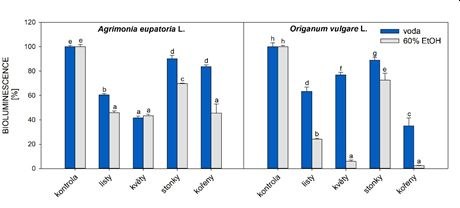Is it better to drink tea made from the leaves or roots of Agrimonia eupatoria L. or Origanum vulgare L.? And how does the pathogenic bacterium Pseudomonas aeruginosa like it?
Pseudomonas aeruginosa causes chronic lung disease, leading to respiratory failure and even death. Moreover, it is an antibiotic-resistant bacterium, which is a pressing problem worldwide. Thus, there has been an ever-increasing search for novel natural antimicrobial compounds.
Traditionally, the aerial parts of Agrimonia eupatoria L. and Origanum vulgare L. are commonly used as teas or alcoholic tinctures because of their health-promoting and antibacterial properties. In this project, the team of the Department of Biochemistry in collaboration with talented high school students Eliška Sladkovská (Gymnázium Nový PORG) and Daniel Šmíd (Gymnázium da Vinci) investigated the antimicrobial effects of all plant parts, i.e. extracts of leaves, flowers, stems and roots in the form of hot infusion (tea) or in 60% ethanol (tincture) against P. aeruginosa. To determine the effect of the extracts on the survival of bacteria, a luminescent strain of P. aeruginosa, which emits light when alive, was used. The figure illustrates how the bioluminescence corresponding to the number of living bacteria decreases owing to extracts from different parts of the plants.
Additionally, the antimicrobial effects were compared with the antioxidant properties and phenolic compound content of the plant extracts. The ethanolic extracts of O. vulgare roots and flowers had the highest antimicrobial activity, followed by those of A. eupatoria roots. Namely, chlorogenic acid, protocatechuic acid, hesperidin, shikimic acid, rutin, quercetin, and morin were highly abundant in the ethanolic extract of O. vulgare roots. Thus, it appears that the synergistic effects of various phenolic compounds and flavonoids may play a key role in the antibacterial activity of teas and tinctures.

Bělonožníková, K., Sladkovská, E., Kavan, D., Hýsková, V., Hodek, P., Šmíd, D., Ryšlavá, H.: Effect of Agrimonia eupatoria L. and Origanum vulgare L. leaf, flower, stem, and root extracts on the survival of Pseudomonas aeruginosa. Molecules 28 (2023), https://doi.org/10.3390/molecules28031019
Document Actions